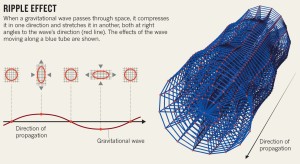Aussie innovation helps hunt down gravitational waves
For the first time in history, astronomers have observed elusive gravitational waves ”“ ripples in the fabric of space-time called gravitational waves, arriving at the earth from a cataclysmic event in the distant universe.
This confirms a major prediction of Albert Einstein’s 1915 general theory of relativity and opens an unprecedented new window to the cosmos.
Australian universities are part of an international project team which has spent the past seven years putting together gravitational-wave detector equipment used to regularly measure gravitational waves. The detectors use powerful lasers to measure vibrations of mirrors suspended four kilometres apart at the ends of huge vacuum pipes.
The discovery, announced today in Washington, was made by the Advanced Laser Interferometer Gravitational-wave Observatory (LIGO) in the USA, which comprises two giant detectors that are four kilometres long and 4000 kilometres apart, housing the most sensitive equipment ever made.
Scientists from Australian universities and CSIRO are celebrating their part in the discovery of the waves, which were predicted by Einstein 100 years ago and open a new window into the cosmos.
In order to aid the hunt for gravitational waves, LIGO recently received $200 million worth of upgrades. One of the major components of this was the installation of ultra-high-performance optical mirrors, many of which were coated by researchers from CSIRO.
According to Dr Cathy Foley, Science Director of CSIRO Manufacturing, the upgrade of the LIGO detectors increased the sensitivity of the system by around tenfold.
“Through the use of interferometry, which is the merging of two sources of light, LIGO is designed to measure changes between the two arms of each detector. The two giant detectors, which are located on opposite sides of the US, are then compared to confirm the findings,” Dr Foley said.
“The interferometer system includes a series of mirrors which are coated with multiple, precisely-controlled layers of optical materials to give the required reflective properties, and lastly a top layer of gold, designed for thermal shielding.
“The coatings, which were developed and applied at CSIRO, are among the most uniform and precise ever made.
“This precision ensures that LIGO’s laser remains clean and stable as it travels through the detectors.
“We really are world leaders in this area, and are thrilled to play a part in this discovery,” she said.
Predicted by Einstein’s general theory of relativity, scientists have long suspected gravitational waves were real, however this is the first piece of direct evidence that proves they exist.
Physicists have concluded that the detected gravitational waves were produced during the final fraction of a second of the merger of two black holes to produce a single, more massive spinning black hole.
According to Dr Simon Johnston, Head of Astrophysics at CSIRO, this is an immensely important discovery for physics and astronomy.
“Gravitational waves exert a powerful appeal. Back in 1915 Einstein proposed that space-time is a four-dimensional fabric that can be pushed or pulled as objects move through it.
“If you run your hand through a still pool of water waves will follow in its path, spreading throughout the pool.
“Now that we’ve caught these waves, we can use them to see the Universe in entirely different ways to what was previously possible.”
The discovery, accepted for publication in the journal Physical Review Letters, was made by the LIGO Scientific Collaboration.
The Australian Partnership in Advanced LIGO was led by Australian National University. Scientists from CSIRO, the University of Adelaide, The University of Melbourne, the University of Western Australia, Monash University and Charles Sturt University, also contributed to the discovery.
Short URL: https://indiandownunder.com.au/?p=6289

